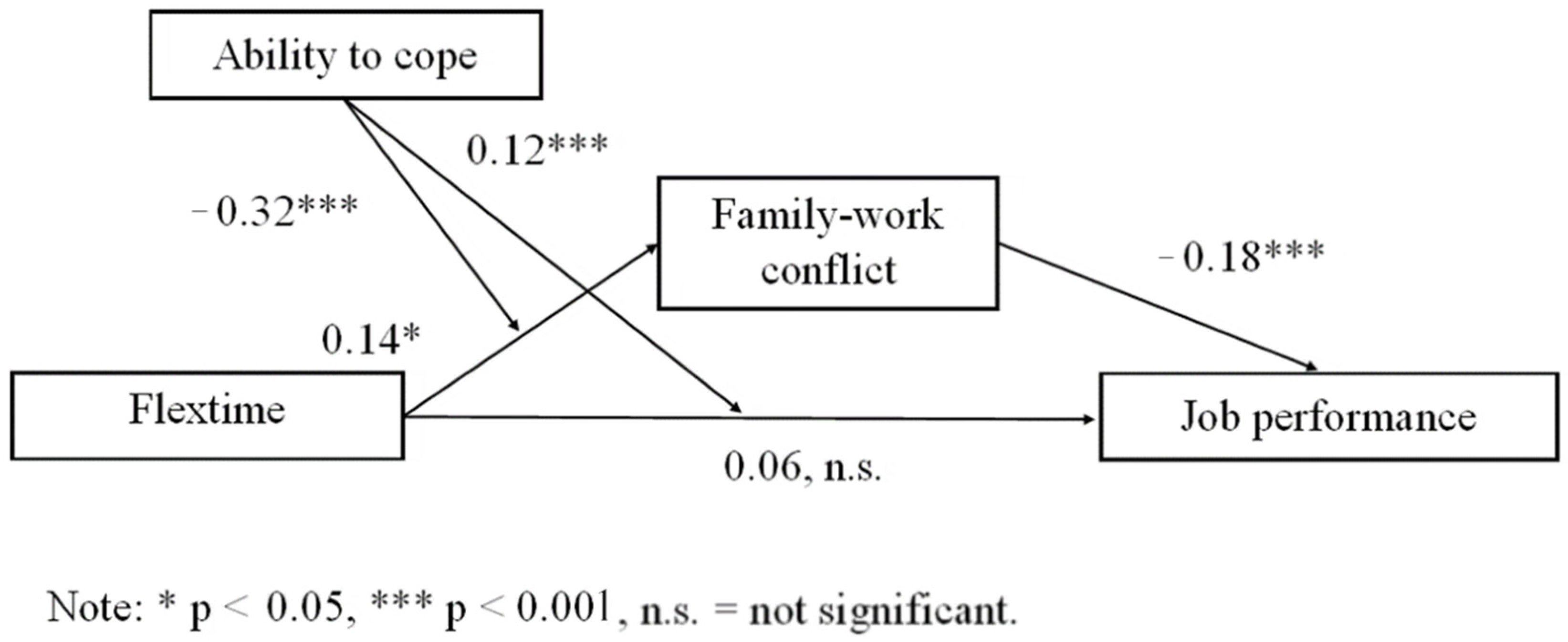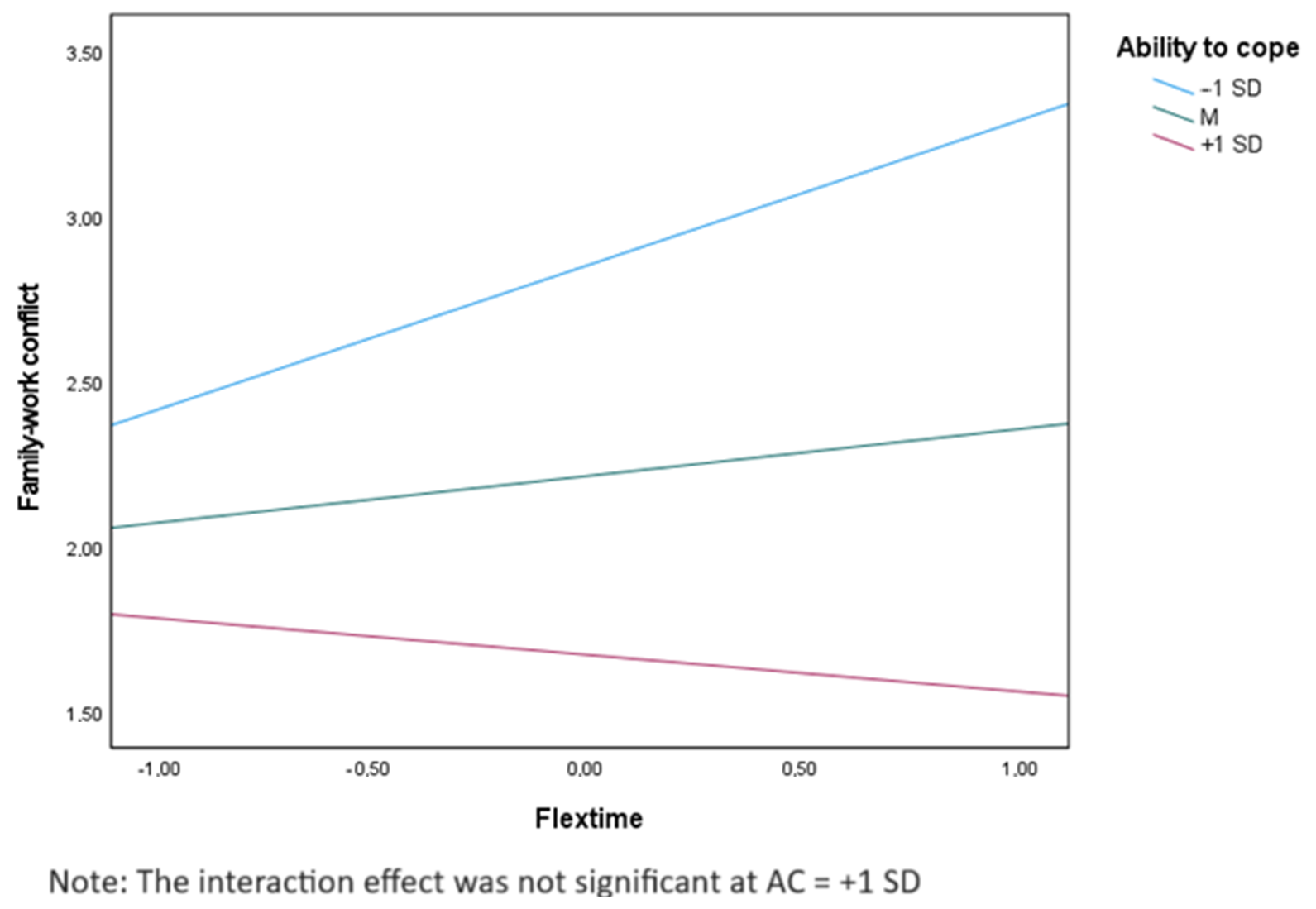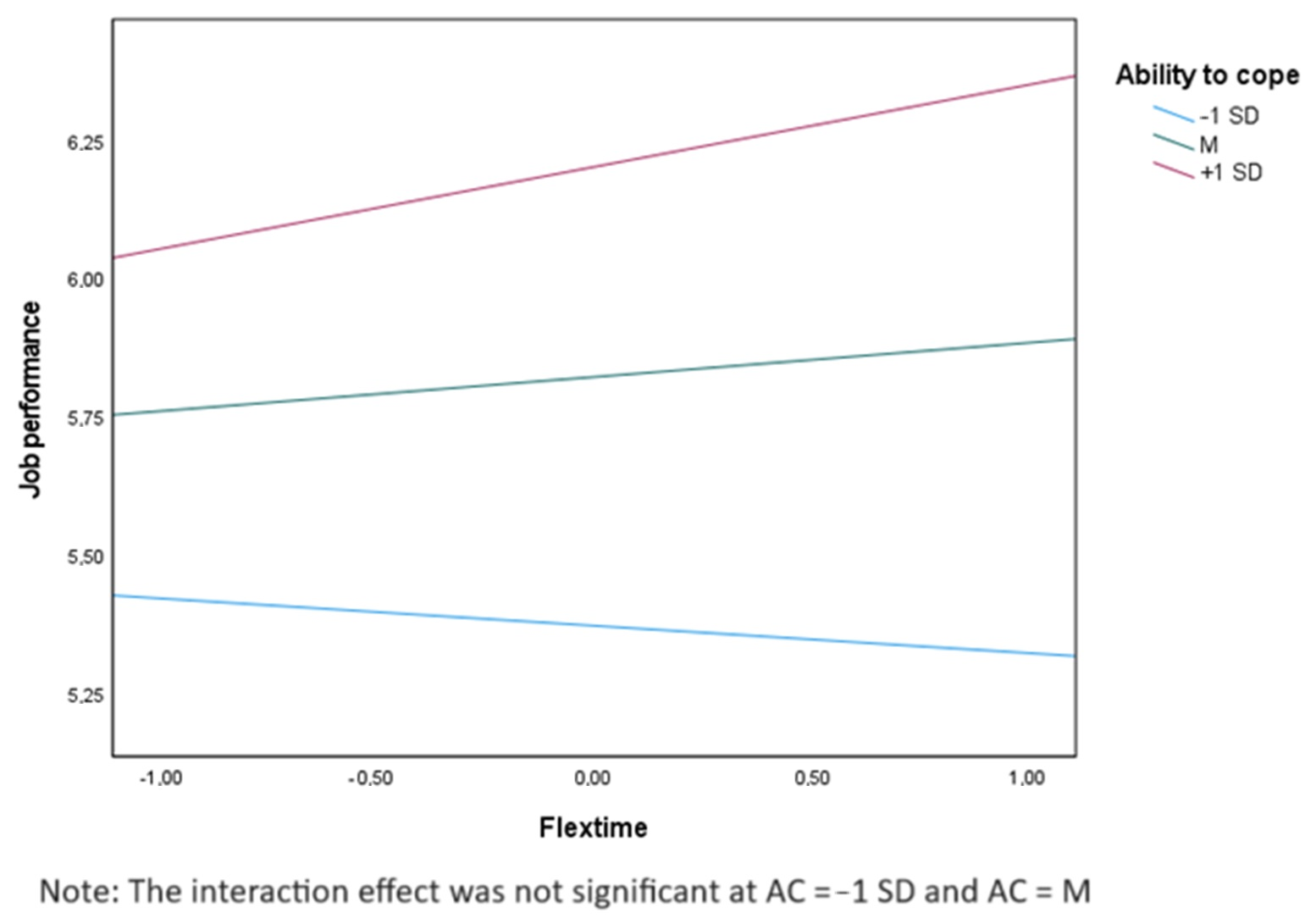Unveiling the Relationship between Flextime and Job Performance: The Role of Family–Work Conflict and the Ability to Cope in a Moderated Mediation Model
Abstract
:1. Introduction
2. Literature Review and Hypotheses Development
2.1. Flextime and Job Performance
2.2. The Mediating Effect of Family–Work Conflict
2.3. The Moderating Effect of Ability to Cope
3. Methods
3.1. Participants and Procedure
3.2. Measures
3.3. Data Analysis
4. Results
4.1. Reliability and Validity of the Measures
4.2. Descriptive Analyses and Correlations
4.3. Model Testing
5. Discussion
5.1. Theoretical Implications
5.2. Practical Implications
5.3. Limitations and Future Research
6. Conclusions
Author Contributions
Funding
Institutional Review Board Statement
Informed Consent Statement
Data Availability Statement
Conflicts of Interest
References
- Allen, Tammy D., Ryan C. Johnson, Kaitlin M. Kiburz, and Kristen M. Shockley. 2013. Work–Family Conflict and Flexible Work Arrangements: Deconstructing Flexibility. Personnel Psychology 66: 345–76. [Google Scholar] [CrossRef]
- Allen, Tammy D., Timothy D. Golden, and Kristen M. Shockley. 2015. How Effective Is Telecommuting? Assessing the Status of Our Scientific Findings. Psychological Science in the Public Interest 16: 40–68. [Google Scholar] [CrossRef]
- Baltes, Boris B., Thomas E. Briggs, Joseph W. Huff, Julie A. Wright, and George A. Neuman. 1999. Flexible and Compressed Workweek Schedules: A Meta-Analysis of Their Effects on Work-Related Criteria. Journal of Applied Psychology 84: 496–513. [Google Scholar] [CrossRef]
- Bandura, Albert. 1997. Self-Efficacy: The Exercise of Control. New York: W.H. Freeman and Company. [Google Scholar]
- Byron, Kristin. 2005. A Meta-Analytic Review of Work–Family Conflict and Its Antecedents. Journal of Vocational Behavior 67: 169–98. [Google Scholar] [CrossRef]
- Chatterjee, Sheshadri, Ranjan Chaudhuri, and Demetris Vrontis. 2022. Does Remote Work Flexibility Enhance Organization Performance? Moderating Role of Organization Policy and Top Management Support. Journal of Business Research 139: 1501–12. [Google Scholar] [CrossRef]
- Christensen, Kathleen E., and Graham L. Staines. 1990. Flextime: A Viable Solution to Work/Family Conflict? Journal of Family Issues 11: 455–76. [Google Scholar] [CrossRef]
- Chung, Heejung, and Cara Booker. 2023. Flexible Working and the Division of Housework and Childcare: Examining Divisions across Arrangement and Occupational Lines. Work, Employment and Society 37: 236–56. [Google Scholar] [CrossRef]
- Dugan, Alicia G., Russell A. Matthews, and Janet L. Barnes-Farrell. 2012. Understanding the Roles of Subjective and Objective Aspects of Time in the Work-Family Interface. Community, Work and Family 15: 149–72. [Google Scholar] [CrossRef]
- European Commission Eurostat. 2021. How Usual Is It to Work from Home?—Products Eurostat News—Eurostat. Eurostat. 15–17. Available online: https://ec.europa.eu/eurostat/web/products-eurostat-news/-/edn-20210517-2 (accessed on 11 May 2024).
- Gajendran, Ravi S., and David A. Harrison. 2007. The Good, the Bad, and the Unknown about Telecommuting: Meta-Analysis of Psychological Mediators and Individual Consequences. Journal of Applied Psychology 92: 1524–41. [Google Scholar] [CrossRef]
- Greenglass, Esther R., and Lisa Fiksenbaum. 2009. Proactive Coping, Positive Affect, and Well-Being. European Psychologist 14: 29–39. [Google Scholar] [CrossRef]
- Hair, Joseph, William Black, Barry Babin, and Rolph Anderson. 2018. Multivariate Data Analysis: A Global Perspective, 8th ed. Upper Saddle River, NJ: Pearson Education, vol. 8th. [Google Scholar]
- Hobfoll, Stevan E. 2001. The Influence of Culture, Community, and the Nested-Self in the Stress Process: Advancing Conservation of Resources Theory. Applied Psychology 50: 337–421. [Google Scholar] [CrossRef]
- Hobfoll, Stevan E., Jonathon Halbesleben, Jean-Pierre Pierre Neveu, and Mina Westman. 2018. Conservation of Resources in the Organizational Context: The Reality of Resources and Their Consequences. Annual Review of Organizational Psychology and Organizational Behavior 5: 103–28. [Google Scholar] [CrossRef]
- House, Robert J., Randall S. Schuler, and Eliahu Levanoni. 1983. Role Conflict and Ambiguity Scales: Reality or Artifacts? Journal of Applied Psychology 68: 334–37. [Google Scholar] [CrossRef]
- Kattenbach, Ralph, Evangelia Demerouti, and Friedhelm Nachreiner. 2010. Flexible Working Times: Effects on Employees’ Exhaustion, Work-nonwork Conflict and Job Performance. Career Development International 15: 279–95. [Google Scholar] [CrossRef]
- Kelliher, Clare, and Deirdre Anderson. 2010. Doing More with Less? Flexible Working Practices and the Intensification of Work. Human Relations 63: 83–106. [Google Scholar] [CrossRef]
- Kelly, Erin L., Phyllis Moen, J. Michael Oakes, Wen Fan, Cassandra Okechukwu, Kelly D. Davis, Leslie B. Hammer, Ellen Ernst Kossek, Rosalind Berkowitz King, Ginger C. Hanson, and et al. 2014. Changing Work and Work-Family Conflict: Evidence from the Work, Family, and Health Network. American Sociological Review 79: 485–516. [Google Scholar] [CrossRef] [PubMed]
- Lapierre, Laurent M., Paul E. Spector, Tammy D. Allen, Steven Poelmans, Cary L. Cooper, Michael P. O’Driscoll, Juan I. Sanchez, Paula Brough, and Ulla Kinnunen. 2008. Family-Supportive Organization Perceptions, Multiple Dimensions of Work-Family Conflict, and Employee Satisfaction: A Test of Model across Five Samples. Journal of Vocational Behavior 73: 92–106. [Google Scholar] [CrossRef]
- Martínez-Sánchez, Angel, Manuela Pérez-Pérez, Pilar De-Luis-Carnicer, and María José Vela-Jiménez. 2007. Telework, Human Resource Flexibility and Firm Performance. New Technology, Work and Employment 22: 208–23. [Google Scholar] [CrossRef]
- Masuda, Aline D., Steven A. Y. Poelmans, Tammy D. Allen, Paul E. Spector, Laurent M. Lapierre, Cary L. Cooper, Nureya Abarca, Paula Brough, Pablo Ferreiro, Guillermo Fraile, and et al. 2012. Flexible Work Arrangements Availability and Their Relationship with Work-to-Family Conflict, Job Satisfaction, and Turnover Intentions: A Comparison of Three Country Clusters. Applied Psychology 61: 1–29. [Google Scholar] [CrossRef]
- Michel, Jesse S., Lindsey M. Kotrba, Jacqueline K. Mitchelson, Malissa A. Clark, and Boris B. Baltes. 2011. Antecedents of Work-Family Conflict: A Meta-Analytic Review. Journal of Organizational Behavior 32: 689–725. [Google Scholar] [CrossRef]
- Miglioretti, Massimo, Andrea Gragnano, Silvia Simbula, and Marco Perugini. 2023. Telework Quality and Employee Well-being: Lessons Learned from the COVID-19 Pandemic in Italy. New Technology, Work and Employment 38: 548–71. [Google Scholar] [CrossRef] [PubMed]
- Moreira, Ana, Tiago Encarnação, João Viseu, and Manuel Au-Yong-Oliveira. 2023. Conflict (Work-Family and Family-Work) and Task Performance: The Role of Well-Being in This Relationship. Administrative Sciences 13: 94. [Google Scholar] [CrossRef]
- Muller, Dominique, Charles M. Judd, and Vincent Y. Yzerbyt. 2005. When Moderation Is Mediated and Mediation Is Moderated. Journal of Personality and Social Psychology 89: 852–63. [Google Scholar] [CrossRef] [PubMed]
- Naqshbandi, M. Muzamil, Ibrahim Kabir, Nurul Amirah Ishak, and Md Zahidul Islam. 2024. The Future of Work: Work Engagement and Job Performance in the Hybrid Workplace. Learning Organization 31: 5–26. [Google Scholar] [CrossRef]
- Netemeyer, Richard G., James S. Boles, and Robert McMurrian. 1996. Development and Validation of Work-Family Conflict and Family-Work Conflict Scales. Journal of Applied Psychology 81: 400–10. [Google Scholar] [CrossRef]
- Ng, Thomas W. H., and Daniel C. Feldman. 2009. How Broadly Does Education Contribute to Job Performance? Personnel Psychology 62: 89–134. [Google Scholar] [CrossRef]
- Ongaki, Jacob. 2019. An Examination of the Relationship between Flexible Work Arrangements, Work-Family Conflict, Organizational Commitment, and Job Performance. Management 23: 169–87. [Google Scholar] [CrossRef]
- Rau, Barbara. 2003. Flexible Work Arrangements. In Sloan Network Encyclopedia Entry Flexible. Available online: https://wfrn.org/encyclopedia/flexible-work-arrangements (accessed on 11 May 2024).
- Rocereto, Joseph F., Susan Forquer Gupta, and Joseph B. Mosca. 2011. The Role Of Flextime Appeal On Family And Work Outcomes Among Active And Non-Active Flextime Users: A Between Groups And Within Groups Analysis. Journal of Business & Economics Research (JBER) 9: 556. [Google Scholar] [CrossRef]
- Salanova, Marisa, Laura Lorente, and Isabel M. Martínez. 2012. The Dark and Bright Sides of Self-Efficacy in Predicting Learning, Innovative and Risky Performances. The Spanish Journal of Psychology 15: 1123–32. [Google Scholar] [CrossRef]
- Shifrin, Nicole V., and Jesse S. Michel. 2022. Flexible Work Arrangements and Employee Health: A Meta-Analytic Review. Work and Stress 36: 60–85. [Google Scholar] [CrossRef]
- Shirmohammadi, Melika, Wee Chan Au, and Mina Beigi. 2022. Remote Work and Work-Life Balance: Lessons Learned from the COVID-19 Pandemic and Suggestions for HRD Practitioners. Human Resource Development International 25: 163–81. [Google Scholar] [CrossRef]
- Shockley, Kristen M., and Tammy D. Allen. 2012. Motives for Flexible Work Arrangement Use. Community, Work & Family 15: 217–31. [Google Scholar] [CrossRef]
- Solanki, Kalpana Rathore. 2013. Flextime Association with Job Satisfaction, Work Productivity, Motivation&Employees Stress Levels. Journal of Human Resource Management 1: 9–14. [Google Scholar] [CrossRef]
- Spieler, Ines, Susanne Scheibe, Christian Stamov-Roßnagel, and Arvid Kappas. 2017. Help or Hindrance? Day-Level Relationships between Flextime Use, Work-Nonwork Boundaries, and Affective Well-Being. Journal of Applied Psychology 102: 67–87. [Google Scholar] [CrossRef] [PubMed]
- Staples, D. Sandy, John S. Hulland, and Christopher A. Higgins. 1999. A Self-Efficacy Theory Explanation for the Management of Remote Workers in Virtual Organizations. Organization Science 10: 758–76. [Google Scholar] [CrossRef]
- Toscano, Ferdinando, and Salvatore Zappalà. 2020. Smart Working in Italia: Origine, Diffusione e Possibili Esiti. Psicologia Sociale 15: 203–23. [Google Scholar] [CrossRef]
- Toscano, Ferdinando, and Salvatore Zappalà. 2021. Overall Job Performance, Remote Work Engagement, Living with Children, and Remote Work Productivity during the COVID-19 Pandemic: A Mediated Moderation Model. European Journal of Psychology Open 80: 133–42. [Google Scholar] [CrossRef]
- Toscano, Ferdinando, Eleonora Bigliardi, Marina V. Polevaya, Elena V. Kamneva, and Salvatore Zappalà. 2022a. Working Remotely During the COVID-19 Pandemic: Work-Related Psychosocial Factors, Work Satisfaction, and Job Performance Among Russian Employees. Psychology in Russia: State of the Art 15: 3–19. [Google Scholar] [CrossRef]
- Toscano, Ferdinando, Salvatore Zappalà, and Teresa Galanti. 2022b. Is a Good Boss Always a Plus? LMX, Family–Work Conflict, and Remote Working Satisfaction during the COVID-19 Pandemic. Social Sciences 11: 248. [Google Scholar] [CrossRef]
- Wang, Bin, Yukun Liu, Jing Qian, and Sharon K. Parker. 2021. Achieving Effective Remote Working During the COVID-19 Pandemic: A Work Design Perspective. Applied Psychology 70: 16–59. [Google Scholar] [CrossRef]
- Wang, Liyuan, and Tianyi Xie. 2023. Double-Edged Sword Effect of Flexible Work Arrangements on Employee Innovation Performance: From the Demands–Resources–Individual Effects Perspective. Sustainability 15: 10159. [Google Scholar] [CrossRef]
- Wu, Amery D., and Bruno D. Zumbo. 2008. Understanding and Using Mediators and Moderators. Social Indicators Research 87: 367–92. [Google Scholar] [CrossRef]




| Variables | M | SD | 1 | 2 | 3 |
|---|---|---|---|---|---|
| 1. Flextime | 3.91 | 0.83 | |||
| 2. Family-work conflict | 2.19 | 1.47 | 0.05 | ||
| 3. Ability to cope | 6.22 | 0.90 | 0.15 *** | −0.41 *** | |
| 4. Job performance | 5.82 | 1.02 | 0.13 *** | −0.44 *** | 0.54 *** |
| AC Value | Effect | Boot SE | 95% CI LLCI | 95% CI ULCI | Significant |
|---|---|---|---|---|---|
| −1 SD | −0.08 | 0.02 | −0.13 | −0.03 | Yes |
| M | −0.02 | 0.01 | −0.06 | 0.00 | No |
| 1 SD | 0.02 | 0.02 | −0.01 | 0.05 | No |
Disclaimer/Publisher’s Note: The statements, opinions and data contained in all publications are solely those of the individual author(s) and contributor(s) and not of MDPI and/or the editor(s). MDPI and/or the editor(s) disclaim responsibility for any injury to people or property resulting from any ideas, methods, instructions or products referred to in the content. |
© 2024 by the authors. Licensee MDPI, Basel, Switzerland. This article is an open access article distributed under the terms and conditions of the Creative Commons Attribution (CC BY) license (https://creativecommons.org/licenses/by/4.0/).
Share and Cite
Zappalà, S.; Toscano, F.; Bharti, D.; Pietrantoni, L. Unveiling the Relationship between Flextime and Job Performance: The Role of Family–Work Conflict and the Ability to Cope in a Moderated Mediation Model. Soc. Sci. 2024, 13, 317. https://doi.org/10.3390/socsci13060317
Zappalà S, Toscano F, Bharti D, Pietrantoni L. Unveiling the Relationship between Flextime and Job Performance: The Role of Family–Work Conflict and the Ability to Cope in a Moderated Mediation Model. Social Sciences. 2024; 13(6):317. https://doi.org/10.3390/socsci13060317
Chicago/Turabian StyleZappalà, Salvatore, Ferdinando Toscano, Dharan Bharti, and Luca Pietrantoni. 2024. "Unveiling the Relationship between Flextime and Job Performance: The Role of Family–Work Conflict and the Ability to Cope in a Moderated Mediation Model" Social Sciences 13, no. 6: 317. https://doi.org/10.3390/socsci13060317
APA StyleZappalà, S., Toscano, F., Bharti, D., & Pietrantoni, L. (2024). Unveiling the Relationship between Flextime and Job Performance: The Role of Family–Work Conflict and the Ability to Cope in a Moderated Mediation Model. Social Sciences, 13(6), 317. https://doi.org/10.3390/socsci13060317









